A caterpillar is the larval stage of a moth or butterfly. It is the second part of their four-stage life cycle (egg, larva, pupa, adult). Most caterpillars have cylindrical bodies consisting bodies consisting of multiple segments, with three pairs of true legs on the thorax and several pairs of short, fleshy prologs on the abdomen. The head has six small eyes (stemmata) on each side that function in light detection but not in image formation. They have short segmented antennae and strong jaws.
Caterpillars inflict damage by eating the foliage and stems of just about any plant in the flower or vegetable garden, as well as fruit and shade trees. Furthermore, they are voracious eaters and can defoliate a plant in a short period of time. Common signs of caterpillar infestation are holes in leaves and chewed leaf edges as well as leaves that are rolled up or fastened with silk. There are different shades of caterpillars, which include green, black, yellow, orange, blue and red. In this article, get to understand the different types of green caterpillars, their morphologies and effect on environment.
List of Green Caterpillars
- The tomato hornworm (Manduca quinquemaculata)
- The Winter Moth caterpillar (Operophtera brumata)
- The Genista broom caterpillar (Uresiphita reversalis)
- Black Swallowtail caterpillars (Papilio polyxenes)
- Emperor moth caterpillar (Saturnia pavonia
- The green Tiger Swallowtail caterpillar (Papilio glaucus)
- The White-lined Sphinx caterpillar (Hyles lineata)
- Copper Underwing Moth Caterpillar (Amphipyra pyramidea)
- The Luna moth caterpillar (Actias luna)
- The Cabbage White Butterfly Caterpillar (Pieris rapae)
- The Hickory Horned Devil caterpillar (Citheronia regalis)
- The Rustic Sphinx caterpillar (Manduca rustica)
- The European Puss caterpillar (Cerura vinula)
- The Cecropia moth caterpillar (Hyalophora cecropia)
- Hackberry Emperor Caterpillar (Asterocampa celtis)
- Green Cloverworm (Hypena scabra)
- Diamondback Moth Caterpillar (Plutella xylostella)
- Io Moth Caterpillar (Automeris io)
- Rough Prominent Moth (Nadata gibbosa)
- Cloudless Sulphur Butterfly (Phoebis sennae)
- Crowned Slug caterpillar (Isa textula)
- Oak Slug caterpillar (Euclea delphinii)
- Fall Webworm (Hyphantria cunea)
- Spicebush Swallowtail Caterpillar (Papilio Troilus)
- Tobacco Hornworm Caterpillar (Manduca sexta)
- Cross-Striped Cabbage Worm (Evergestis rimosalis)
- Rosy Maple caterpillar (Dryocampa rubicunda)
- Dragon-Headed Caterpillar (Polyura athamas)
- The Angle Shades caterpillars (Phlogophora meticulosa)
- Cabbage looper caterpillars (Trichoplusia ni)
- Long-Tailed Skipper Caterpillar (Urbanus proteus)
- Forester Moth Caterpillar (Zygaenidae)
- Polyphemus Moth Caterpillar (Antheraea polyphemus)
- Common Pine Sawfly (Diprion pini)
- Eumorpha Sphinx Caterpillar (Eumorpha fasciatus)
- Honey Locust Moth Caterpillar (Syssphinx bicolor)
- Northern Pearly-Eye Caterpillar (Enodia anthedon)
- Orange-Barred Sulphur Caterpillar (Phoebis philea)
- Silver-Spotted Skipper Caterpillar (Epargyreus clarus)
- Copper Underwing Moth Caterpillar (Amphipyra pyramidoides)
- Oleander Hawk Moth Caterpillar (Daphnis nerii)
- Box Tree Caterpillar (Cydalima perspectalis)
- Promethea Silkmoth (Callosamia promethea)
- Virginia Creeper Sphinx Moth Caterpillar (Darapsa Myron)
- Gray Furcula Moth Caterpillar (Furcula cinerea)
- Snowberry Clearwing Moth Caterpillar (Hemaris diffinis)
- Bedstraw Hawk-Moth Caterpillar (Hyles gallii)
- Georgian Prominent Caterpillar (Hyperaeschra georgica)
- Lacecapped Caterpillar (Oligocentria lignicolor)
- Regal Moth Caterpillar (Citheronia regalis)
Types Of Green Caterpillars
Tomato Hornworm Caterpillar

Tomato hornworms are green caterpillars the exact shade of tomato leaves, with white diagonal stripes on the sides and a fleshy pointed tip at their tails. They can be up to 5 inches long, something that can be quite shocking when you come across them for the first time. Tomato hornworms gets its name from a dark projection on their posterior end and their use of tomatoes as host plant, though it be a major pest in the garden, it devours leaves of tomato, potatoes, eggplant, pepper and other plants. They are mostly found in North America and Australia.
Tomato hornworms are closely related to and sometimes confused with the tobacco hornworm. The confusion arises often due to the fact that both species have similar morphologies and feed on the foliage of various plants from family and either species can be found on tobacco and tomato leaves.
Winter Moth Caterpillar

Winter moth caterpillars are small green caterpillars with one darker green strip down the center of their back and two white stripes on each side of their body. They move an inching motion forming an arch when they crawl similar to the blueberry spanworm and the chain geometer. These caterpillars can be confused with the blueberry sawfly, which is also a green caterpillar that feeds inside leaf and flower buds.
Native to Northern and central Europe, winter moth caterpillars have potential to cause severe damage to host plants because of their high populations and the manner in which they attack their host plant. They enter the newly opening buds of leaves and flowers and feed on the tissue from the inside out. They eat holes in the leaves, blossom and developing fruitlets of many tree fruits, ornamental trees and shrubs in early spring. Severe attacks can weaken young trees. Extensive damage to fruit trees can affect crop yield and quality.
Also Read: Different Types of Yellow Caterpillars
Genista Broom Moth Caterpillar

Genista caterpillars are the larvae of the genista broom moth also referred to as sophora worm moth. It is a tenting caterpillar that uses silk to spin a tent-like form in the plant and trees where they feed. Genista caterpillars hatch in the fall from clusters of tiny, cream-colored eggs laid on the undersides of leaves by the female broom moths. They feed during the fall and early winter season and spent the winter in the pupal stage. They hatch into adult moths in the spring that feed and mate during the summer.
Genista caterpillars occur commonly in central Texas landscapes, Colorado, Nova Scotia and throughout the gulf cost. They form loose webbing on the foliage and feed on leaves causing unsightly damage. They feed on mountain laurel and other bushes and trees. They eat new foliage, buds, shoots and new leaves.
Parsley Caterpillar (Papilio Polyxenes)
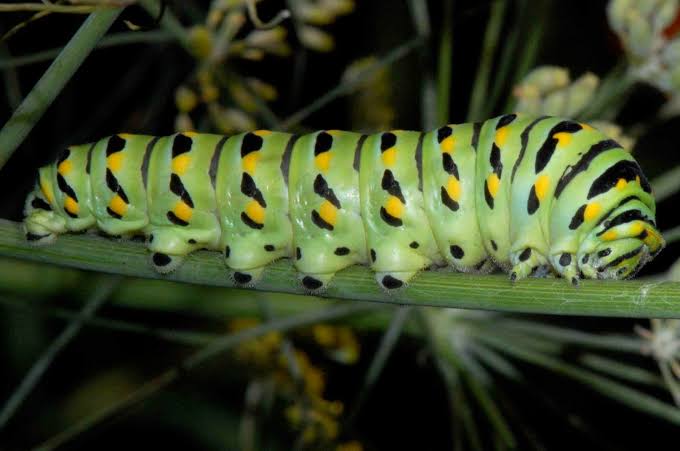
Parsley caterpillars also referred to as Papilio polyxenes are the larvae of the black swallowtail butterfly. This butterfly is found across southern Canada and most of the eastern and mid-western U.S all the way west to the Rocky Mountains. Parsley caterpillars they are referred to as parsley because the caterpillar primarily feeds on parsley and toxins from host plants in the carrot family (carrot, dill, Queene Anne’s lace, parsnips). These caterpillars have a smooth green body with each segment sporting a thin band with yellow-orange spots. In pupal stage, it forms a brown or green chrysalis. It remains in this stage through the winter, emerging as beautiful butterfly in April or May.
When the parsley caterpillars hatch from the egg they are usually tiny. They eat and gradually grow bigger over time. When they are small, the damage is not as noticeable. Once they get large, they can cause a lot of damage quickly. But, it takes a while for that to happen. If you will observe your plant frequently and carefully for early signs of feeding and small caterpillars, you can pick them off and destroy them before they cause so much damage.
Emperor Moth Caterpillar (Saturnia Pavonia)
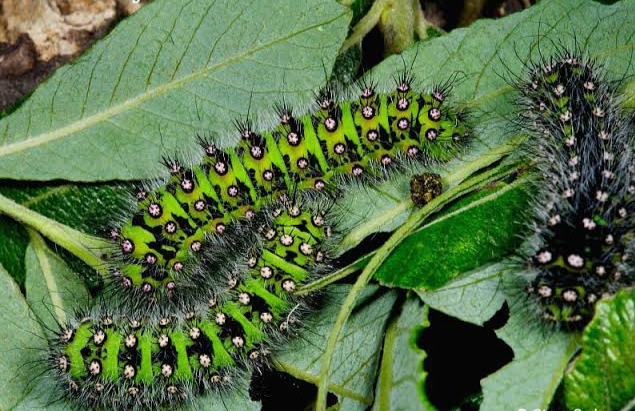
Emperor occurs throughout the Palearctic region and is the only member of its family to be found in the British Isles where it is usually referred to as the Emperor moth. The fully grown caterpillar is green with black hoops containing yellow wart-like spots with spines and feeds on eucalyptus, pepper trees, silver birch, apricot, grape vines etc. the young caterpillars live socially, the mature ones are found more singly and are not very conspicuous. Larval time is from late May to July or early August. The pupa hibernates in a characteristic pear-shaped cocoon.
Also Read: Different Types of Caterpillars With Stripes
Tiger Swallowtail Butterfly (Papilio Glaucus)
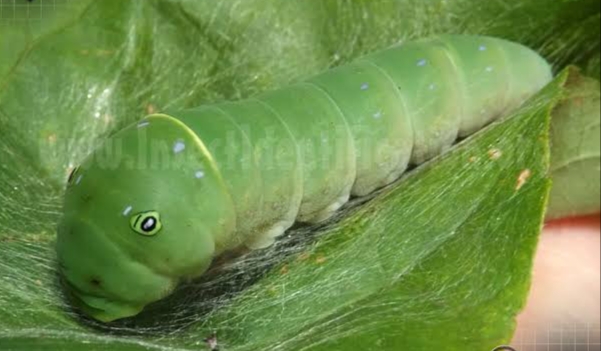
Papilio glaucus, the eastern tiger swallowtail, is a species of butterfly native to North America. It is one of the most familiar butterflies in the eastern United States where it is common in many different habitats. It flies from spring to fall, during which it produces two to three broods. Adults feed on the nectar of many species of flowers.
Tiger Swallowtail caterpillars are amazing animals. Young caterpillars are brown and white. Later, as they mature, the caterpillars turn bright green and have two amazing black, yellow and blue false eyespots on the thorax above and behind true eyes. The true head of the caterpillar is small inconspicuous and tucked under the body.
White-Lined Sphinx Caterpillar

White-lined Sphinx caterpillar is a larvae of white-lined sphinx moth also referred to as Hyles lineata. The white-lined sphinx moth is one of the species commonly referred to as hummingbird moths because they can be as big as hummingbirds. They often are seen hovering to feed on the nectar of flowers, beating their wings rapidly like hummingbirds. They emit an audible hum, similar to that of a hummingbird in flight.
The larvae (caterpillars) show a wide range of color phenotypes. The larvae are green with black spots arranged in lines down the whole body. The caterpillars feed on the foliage of a variety of perennials, shrubs and trees, but rarely do significant damage. There is no reason to spray them, instead, look forward to the beautiful and fascinating insects these larvae will turn into.
Copper Underwing Caterpillar
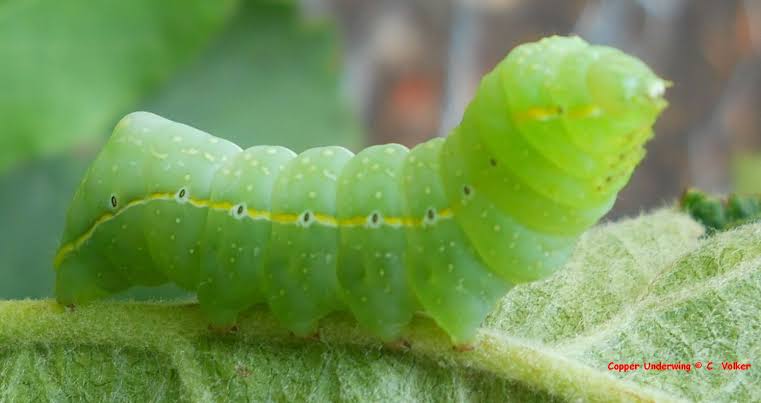
Copper underwing caterpillar is a larvae of the copper underwing moth. The caterpillar is pale green and has a peak-shaped hump near the rear end. It is often parasitized by wasps and other insects and their white capsule-shaped eggs may be sticking to its body. Food sources for the caterpillar are varied and numerous. Vines like Virginia creeper, raspberry and grape offer leafy nutrition. Leaves from oak, willow, elm, maple and birch trees are also eaten.
This species can be found throughout the US and southern Canada as well as across the Palaearctic region including Europe, North Africa, the Near East, Iran, southern Siberia, northern India, Korea and Japan.
Luna Moth Caterpillar

Lunar moth caterpillars are larvae of Luna moth. The larvae are bright green in color, the segments convex (expanded outward) with narrow yellow bands positioned at the hind part of each segment; a yellowish lateral (side) stripe runs below the spiracles (small holes that allow air into respiratory organs), and three lateral rows of reddish tubercles on each side; the head is brownish. Luna mothsare usually found in and near deciduous woodlands, they eat the foliage of walnuts, persimmon, sweet gum, sumacs, hickories pecan etc.
Cabbage White Caterpillar

Cabbage white caterpillars are larvae of cabbage white butterfly also referred to as Pieris rapae. It is known in Europe as the small white, in North America as the cabbage white or cabbage butterfly. The butterfly is recognizable by its white color with small black dots on its wings. The cabbage white caterpillars are bluish-green, with tiny black pints, a black ring around the spiracles and a lateral row of yellow dashes and a yellow middorsal line.
Hickory Horned Devil Caterpillar
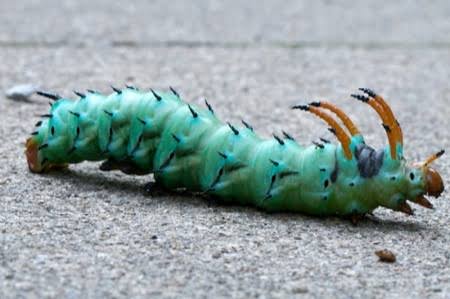
Hickory horned devil is a blue-green colored caterpillars covered with long black thorns, it looks fierce and can be almost as big as a hot dog, but they are harmless. It is believed to be the largest caterpillar in United States and the world at large. They are often seen feeding on the leaves of deciduous forest trees such as hickory, pecan, sweetgum, sumac and persimmon. The small caterpillars eat very small amounts of foliage, but in later stages consume considerable amounts of leaves.
This worm starts as a tiny caterpillar after hatching from one of hundreds of eggs laid by a regal moth. Over a matter of weeks, it grows and molts until it reaches its amazing size, about 6 inches. The fully grown hickory horned devil has a brown head, dark green body, black prologs and numerous spines. Each body segment has four or more short, black spines around in a row around it.
Rustic Sphinx Caterpillar
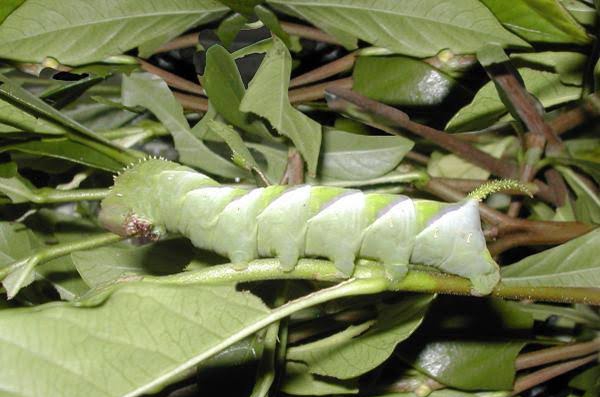
The rustic sphinx caterpillar is bright green with white to yellow diagonal stripes bordered with darker green to purple-black on the top of each stripe. The horn at the end is harmless and has tiny bumps that help distinguish the rustic sphinx from other hornworms. The color and pattern is constant as hornworm molts and grows. After three weeks, the upper surface becomes light reddish-brown just before the caterpillar crawls down to pupate in the soil.
Rustic sphinx caterpillars have been found to feed on American beautyberry, ash, basil, butterfly bush, crape myrtle, cross vine, desert willow, forked bluecurls, fringed tree, jasmine, sunflower, sesame and lantana. The caterpillar often makes a visit in bloom at night including flowers with deep corollas such as petunia.
Puss Moth Caterpillar (Cerula vinula)

The European puss moth caterpillar also referred to as Cerura vinula is a larvae of the puss moth. The puss moth is generally medium sized species of moth that is found across Europe and in parts of North Africa. The puss moth caterpillar is typically green in color with a dark looking spike protruding from one end and a colorful face on the other. When threatened, the puss moth caterpillar is known to spray formic acid at its attacker to minimize the chance of it being eaten (it is among the most dangerous species of caterpillar).
Puss moth caterpillar can be found in a wide range of habitats including moorland, gardens and open woodland. They commonly feed on foliage of poplar, willow and maple. Generally, the puss moth is becoming rarer as much of its native woodland has been threatened by deforestation or air and noise pollution.
Cecropia Moth Caterpillar
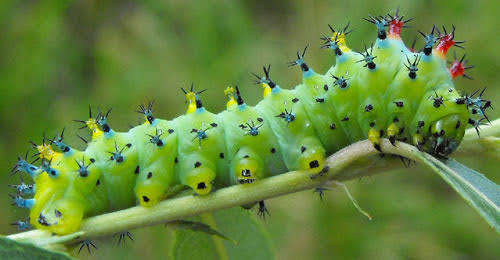
These moths can be found all across North America as far west as Washington and north into the majority of Canadian provinces. Cecropia caterpillars take most of the summer to mature and are up to four inches long when fully developed. They are bluish green and along the back there is a pair of yellow projections on each body segment. The first three pairs of tubercles are more conspicuous and are in the form of yellow balls with black spines. These larvae feed upon many common trees and shrubs including maple, plum, birch, box elder, elm, sassafras, lilac, cherry and apple.
In early fall the mature caterpillar spines as spindle-shaped cocoon which is about three inches long. The cocoon is attached along its full length to a twig on the host tree. Inside the cocoon, the caterpillar changes to a pupa, the life stage in which it spends the winter.
Hackberry Emperor Caterpillar (Asterocampa celtis)
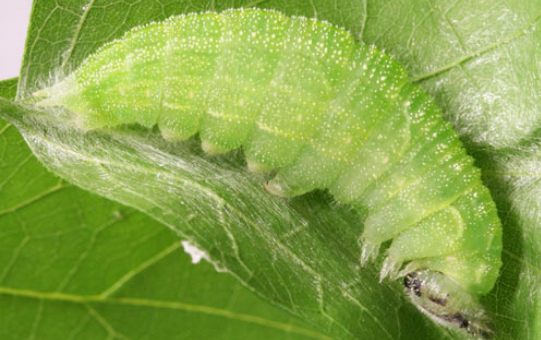
Photograph by Donald W. Hall, University of Florida.
The Hackberry Emperor caterpillar is relatively small and inconspicuous compared to some other butterfly caterpillars. It typically measures around 1.5 to 2 inches in length. The caterpillar has a cylindrical body covered in tiny, hair-like structures called setae. Its coloration can vary, but it often features shades of green or yellowish-green with a prominent light-colored or yellow stripe running along its back.
As the name suggests, the Hackberry Emperor caterpillar primarily feeds on the leaves of hackberry trees (Celtis spp.). These trees are widespread in North America. Hackberry Emperor caterpillars are known for their solitary behavior. They feed on hackberry leaves and are often found resting on the underside of the leaves or hiding among the foliage to avoid predators.
The Hackberry Emperor butterfly is found across much of North America, from southern Canada down to Mexico. It is often encountered in open woodlands, forest edges, and other habitats where hackberry trees grow.
Adult Hackberry Emperors have distinctive markings on their wings, including a series of eyespots on the underside of the hindwings.
Also Read: Different Types of Black Caterpillars
Angles Shades Moth Caterpillar

This bright green to brownish yellow caterpillar is the larval stage of the Angle Shades moth. It feeds on quite a few woody and herbaceous plants including dock, nettle, bramble, oak and some ornamental plants, leaving holes in the foliage and damaging flower buds. When disturbed, the caterpillar adopts a ‘’c’’ shape. They measure about 35mm and 45mm in length.
Angle shades caterpillar are not usually found in great numbers, only one or two when clearing up around plants as they hide during the day and emerge at night to feed. These caterpillars feed on a wide range of plants including dock and stinging nettles. The damage is mostly caused between May and October, but they are active for most of the year. The angle shade moth is quite common in parks and gardens, as well as in scrub and along woodland edges and hedgerows.
Green Cloverworm (Hypena scabra)

The Green Cloverworm caterpillar can be distinguished by its yellow-green head, slender yellow stripes encircling its body, and a pale greenish-white stripe running down its sides. Another method of identifying this green larva is by noting its three pairs of abdominal prolegs and one pair at its rear.
When disturbed, Green Cloverworms exhibit a unique behavior characterized by wriggling, resembling a jumping and flopping motion.
These caterpillars, also known as black snouts, typically measure between 1 to 1.2 inches (2.5 to 3 cm) in length. They are destructive pests that primarily consume soybeans and other leguminous crops.
Following the pupal stage, Green Cloverworms transform into dark brown moths with triangular wings.
Diamondback Moth Caterpillar (Plutella xylostella)

Larva feeding on leaves. Photo by Andrew Weeks, Cesar Australia
These caterpillars are green with a yellowish hue and are marked by a series of faint, diamond-shaped spots along their back, which gives them their name. They are relatively small, measuring about 10-12 mm in length when fully grown. An identifying feature of the diamondback moth caterpillar is the five pairs of prolegs, one of which forms a distinctive V shape at its rear.
Diamondback moth caterpillars are voracious feeders and can cause significant damage to cruciferous crops by consuming leaves, stems, and flower buds. T hey feed on plant tissues, leaving behind irregularly shaped holes and extensive damage to the leaves, which can reduce crop yields and quality.
Cabbage Looper Caterpillars
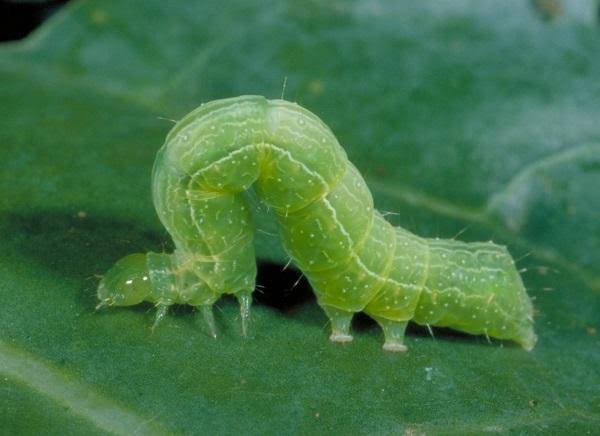
Widely distributed throughout North America, the cabbage looper is common and destructive pest most often found on cabbage-family or cole crops. The cabbage looper also attacks carnations, nasturtium, lettuce, spinach, beets, parsley, potatoes and tomatoes.
The larva of cabbage loopers is what’s referred to as cabbage looper caterpillar. They are generally pale green caterpillars with a narrow white stripe along each side and several narrow lines down the back. It crawls in a looping motion. The larvae feed on the underside of developing leaves. Outer leaves become riddled with small irregular holes. In the larval stage, cabbage loopers eat three-times their body weight in plant material a day, the larger its larvae grow the more damage they do.
Imperial Moth Caterpillar

The caterpillar or larvae of the imperial moth is green in color and has yellow knobs on their thorax and yellow spots down each side. Mature caterpillars are covered with long, fine hair, this caterpillar can reach a length of 5 inches, be big as a person’s thumb. The larvae of imperial moth burrow into the ground and form an earthen chamber in which they transform to a pupa. If the caterpillar is found on the ground, chances are it has completed feeding and is searching for a place to pupate.
These caterpillars feed on many trees including oak, maple, linden, birch, elm, walnut, cedar and pine. In spite of the fact that this large caterpillar can consume a considerable amount of foliage, it doesn’t cause any significant damage. The caterpillars mature in the fall and that’s probably the time of the year many people encounter it.
The adult moth is beautiful Imperial moths and can have wingspan of four to five inches. Imperial moths are generally widely spread from Argentina to Canada and from the Rocky mountains to the Atlantic cost.
Io Moth Caterpillar (Automeris io)
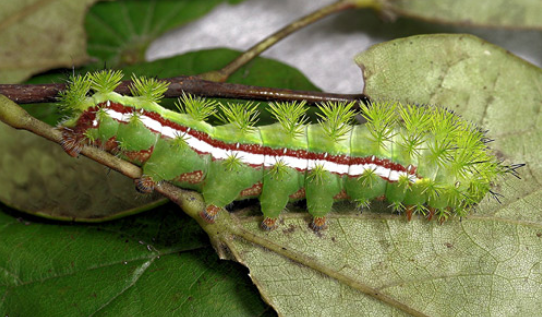
Photograph by Donald W. Hall, University of Florida.
Automeris io, the Io moth or peacock moth, is a colorful North American moth in the family Saturniidae. The Io moth is also a member of the subfamily Hemileucinae. The name Io comes from Greek mythology in which Io was a mortal lover of Zeus. The io moth (Automeris io) is characterized by yellow males and red-brown females, and both sexes have a large, dark eyespot on each hindwing.
Io Moth Caterpillars have a bright green body covered in spiky, branched spines with red and white stripes running along the sides of the body. These caterpillars can grow to be around 2 to 3 inches (5 to 7.5 centimeters) in length. They are covered with barbed, stinging (urticating) hairs that remain in the skin of predators or someone unlucky enough to brush against one.
Young caterpillars feed together as a group and move in long “trains” while older caterpillars feed alone. Papery cocoons are spun in litter under the host plant or in crevices. Io Moth Caterpillars are herbivores and feed on a variety of host plants, including oak, cherry, and willow trees. They are often found munching on leaves.
Io Moth Caterpillars are found in the eastern and central parts of North America, including the United States and parts of Canada.
The Regal Moth Caterpillar
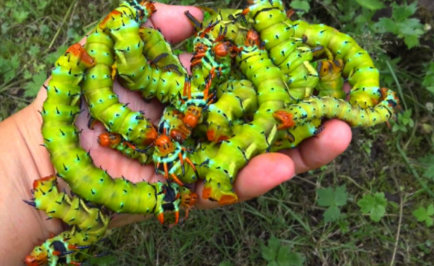
The Regal Moth Caterpillar, has a large, robust body covered in vivid green and small blue or black tubercles (protrusions) along its sides. The most remarkable feature of this caterpillar is the series of large, curved, and intimidating spines on its thoracic segments, which resemble thorns or horns, adding to its regal appearance. At maturity, it can reach lengths of up to 3 to 4 inches (7.5 to 10 centimeters).
Citheronia regalis caterpillars are primarily found in eastern North America, where they inhabit deciduous forests, especially oak and hickory woodlands. They are most commonly spotted in states like Florida, Georgia, South Carolina, and other parts of the southeastern United States. They feed on the leaves of various deciduous trees, particularly oak species, during their larval stage before undergoing metamorphosis into the equally magnificent Regal Moth.
Bedstraw Hawk-Moth Caterpillar (Hyles gallii)
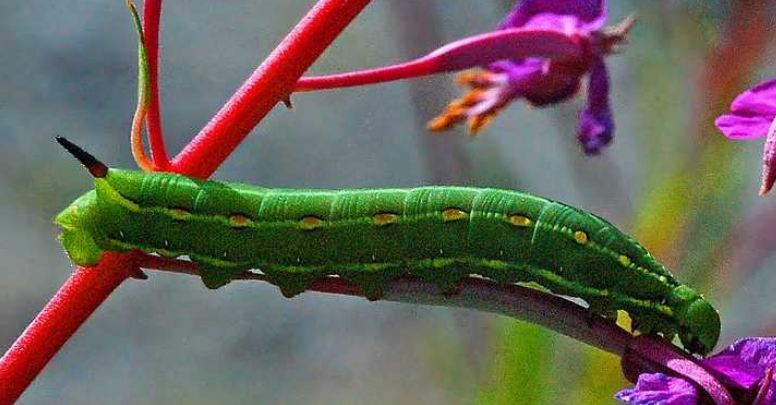
The Bedstraw Hawk-Moth Caterpillar (Hyles gallii) is found in various parts of Europe and Asia. Its distribution range spans across different countries and regions within these continents. The caterpillar is often associated with its preferred host plants, which are typically species of Galium, commonly known as bedstraw plants.
The Bedstraw Hawk-Moth Caterpillar has a long, slender body with a predominantly green coloration. Along its sides, you can observe a series of white or yellowish diagonal stripes or bands, often outlined in black. These bands give it a striking and eye-catching appearance. The caterpillar also has a “horn” at the rear end, which is a defensive structure.
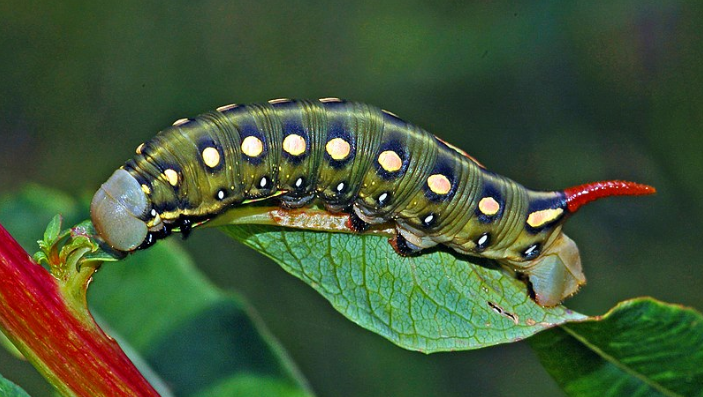
The caterpillar has evolved to resemble a small snake, with its horn resembling the snake’s head. When threatened or disturbed, it can inflate the horn, making it appear more snake-like.
Bedstraw Hawk-Moth Caterpillars are mainly nocturnal and are most active at night. During the day, they often rest on their host plants or nearby vegetation. They are solitary in nature and do not form social groups.
Georgian Prominent Caterpillar (Hyperaeschra georgica)
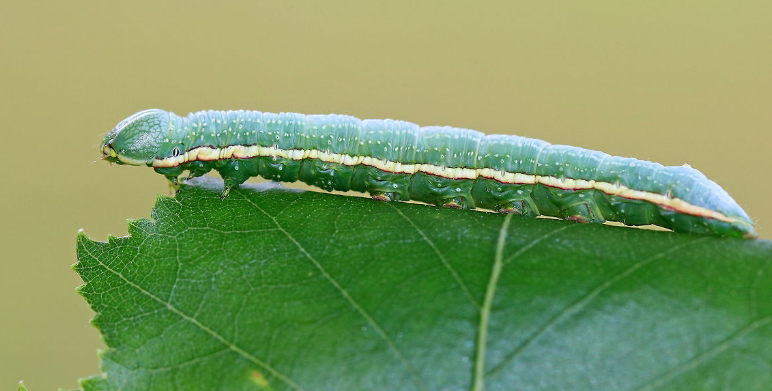
Hyperaeschra georgica, the Georgian prominent, is a species of moth in the family Notodontidae (the prominents). It was first described by Gottlieb August Wilhelm Herrich-Schäffer in 1855 and it is found in North America and parts of Australia.
The larval stage of the Georgian prominent moth is characterized by a sizable, light green caterpillar with a continuous yellow stripe running along its body. Furthermore, this elongated caterpillar exhibits rows of small, barely noticeable green markings on its dorsal side. One distinctive trait of this green caterpillar is the reddish-orange protrusion at its posterior end.
The caterpillar of the Georgian prominent moth consumes the foliage of deciduous trees across North America as its primary source of nutrition.
Lacecapped Caterpillar (Oligocentria lignicolor)

The Lace-capped Caterpillar, scientifically known as Oligocentria lignicolor, is a species of caterpillar belonging to the family Notodontidae, which is commonly referred to as the prominent moths or prominents.
They have a unique coloration with a mix of brown, green, and white markings. The name “lace-capped” comes from the lacy pattern of white markings on the thorax, which resembles lace or intricate designs. These caterpillars reach a length of about 2 inches (5 centimeters).
Lace-capped Caterpillars are found in eastern North America, primarily in deciduous forests and woodlands. They can be found on various tree species, including oak, hickory, and walnut.
The adult form of Lace-capped Caterpillars, the prominent moth, is typically brown or gray with a robust body. They are nocturnal and are attracted to light sources at night. Adult moths are responsible for mating and laying eggs to continue the life cycle.
Snowberry Clearwing Moth Caterpillar (Hemaris diffinis)
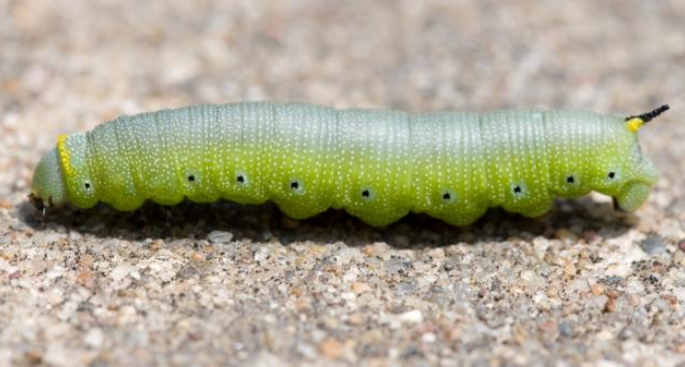
These caterpillars are found throughout much of North America, from southern Canada to Mexico. Snowberry clearwing caterpillars are usually green with black spots around the spiracles. Behind the head is a yellow “collar.” The tail horn on this species is black with a yellow base. The caterpillar’s overall appearance mimics that of a snake, which is a form of defensive mimicry. These caterpillars typically grow to be about 2 inches (5 centimeters) in length.
Snowberry Clearwing Moth caterpillars primarily feed on the leaves of various plants, including honeysuckle (Lonicera spp.) and snowberry (Symphoricarpos spp.), hence the name “Snowberry” in their common name. Like other members of the Sphinx Moth family (Sphingidae), Snowberry Clearwing Moth caterpillars are known for their rapid and purposeful movement.
Goatweed Leafwing Butterfly Caterpillar (Anaea andria)

Caterpillars are grayish green with small raised dots; the head is grayish green with small protuberances. The coloration can range from green to brown or even pinkish-red, depending on their age and the specific plant they feed on. This species is found in North and Central America. It ranges from the southern United States, through Mexico and Central America, down to parts of South.
The size of the caterpillar can vary, but they typically reach lengths of around 1.5 to 2 inches (3.8 to 5 centimeters) when fully grown. This species is often found in a variety of habitats, including open woodlands, fields, and gardens.
Goatweed Leafwing caterpillars feed on the leaves of plants belonging to the genus Croton, commonly known as “goatweed.” These caterpillars are specialized feeders, and their diet consists primarily of these plants.
After the caterpillar reaches maturity, it typically undergoes pupation, where it transforms into a chrysalis. During this stage, it goes through metamorphosis, eventually emerging as an adult butterfly.
Gray Furcula Moth Caterpillar (Furcula cinerea)

Furcula cinerea, the gray furcula moth, is a species of moth in the family Notodontidae. It was first described by Francis Walker in 1865. It is found in the United States, southern Canada and the Northwest Territories. The wingspan is 33–45 mm. They inhabit a range of forested and woodland environments.
Gray Furcula Moth Caterpillars are grayish or brownish in color with various markings, which can include lines, spots, and patterns that help them blend into their natural habitat. They have a robust and somewhat wrinkled appearance. In addition, the strange green caterpillar has an elongated pointed tail and flattened head.
They have two prominent “horns” or elongated projections at the front end of their bodies. These horns can resemble the appearance of a forked tongue, which is why they are sometimes called “snake-headed caterpillars.”
The caterpillars of Furcula cinerea feed on the leaves of Betula (birch), Populus (poplar), and Salix (willow). In the southern regions, they can be found from spring to fall. In northern areas, they can be seen for a shorter period, from July to August.
Virginia Creeper Sphinx Moth Caterpillar (Darapsa Myron)

The Virginia Creeper Sphinx Moth Caterpillar is typically green in color and exhibits a slender, elongated body. One of its most distinguishing features is a horn-like projection on its posterior end, which is a characteristic of many Sphinx moth caterpillars.
This caterpillar often features diagonal white lines or stripes along its sides, giving it a striking and visually appealing appearance. These markings can vary in intensity and may sometimes appear as pale yellow or cream-colored lines.
The Virginia Creeper Sphinx Moth Caterpillar is named after its preferred host plant, Virginia creeper (Parthenocissus quinquefolia). It is also known to feed on other plants within the grape family (Vitaceae), including various grapevine species.
The caterpillars of Darapsa myron are commonly found in the eastern United States, particularly in states extending from Florida in the south to Maine in the north. They inhabit a range of habitats, including woodlands, gardens, and areas where their host plants grow.
Promethea Silkmoth caterpillar (Callosamia promethea)

The caterpillar of the Promethea silkmoth can be described as a chubby, bluish-green larva adorned with four prominent red rounded horns at its head and a yellow tail. Additionally, it displays rows of bluish-black tubercles running along its sides and back. Furthermore, you will observe that its front and rear legs are of a pale-yellow hue.
The Promethea silkmoth caterpillar attains a length ranging from 1.77 to 2.36 inches (4.5 to 6 cm). These sizable, plump green caterpillars primarily consume the leaves of various deciduous trees and ornamental plants. They also feed on the spicebush (Lindera benzoin), which is responsible for their alternate common name, the spicebush silkmoth caterpillar.
Box Tree Caterpillar (Cydalima perspectalis)

The larva of the box tree, characterized by its black, yellow, and green stripes, features distinctive attributes such as a circular black head marked by a white “V” pattern, bands of green, yellow, and black running along its abdomen, and black spots on its dorsal side. Additionally, this caterpillar is adorned with delicate white spines.
The green and black box tree caterpillar reaches a length of approximately 1.5 inches (4 cm). As implied by its common name, this striped green caterpillar primarily consumes plants within the Buxus species. In certain instances, these green larvae can entirely strip the foliage from boxwood shrubs.
Oleander Hawk Moth Caterpillar (Daphnis nerii)

Daphnis nerii, the oleander hawk-moth or army green moth, is a moth of the family Sphingidae. It was described by Carl Linnaeus in his 1758 10th edition of Systema Naturae.
The Oleander Hawk Moth Caterpillar has a lime green body with diagonal purple bands and black spots. As the name suggests, this caterpillar primarily feeds on the leaves of oleander plants (Nerium oleander). They also have a preference for fragrant species like petunia, jasmine and honeysuckle. When fully grown, they can reach lengths of approximately 4 to 5 inches (about 10 to 12 centimeters).
The Oleander Hawk Moth Caterpillar is found in various regions across the world, including parts of Africa, Asia, Europe, and the Middle East. It is known for its migratory behavior and can be spotted in different parts of its range during different seasons. They are especially active in the twilight time, hovering over the flowers after sunset.
These caterpillars are known for their large size and voracious appetite. They can defoliate oleander plants rapidly, which sometimes leads to conflicts with gardeners or people who cultivate oleanders.
Copper Underwing Moth Caterpillar (Amphipyra pyramidoides)

The Copper Underwing Moth (Amphipyra pyramidoides) is a species of moth found in North America. The name “Copper Underwing” refers to the copper-colored hindwings that are typically hidden when the moth is at rest. These moths are part of the family Noctuidae, which includes a diverse group of moths commonly known as owlet moths.
Copper Underwing Moth caterpillars are relatively large and robust. They have a cylindrical body and are light green and blend in well to their surroundings.The larva is also identified by its conspicuous humped tail part and rounded green head. It also has yellow and white band along its sides. In addition, on the colorful band are several blue dots with a white rim. The caterpillar’s green abdomen is also covered in yellow dots and patterns.
They are sought after by birds as food for their growing nestlings. The caterpillar measures 1.77” (4.5 cm) long. The caterpillar is active in spring, feeding on fruit trees, hawthorn, maple, oak, and other deciduous trees.
Silver-Spotted Skipper Caterpillar (Epargyreus clarus)

These caterpillars are commonly found in North and Central America, including parts of the United States, Mexico, and Canada. They are usually green with a yellow or cream-colored stripe running down the sides of their bodies. They also have a pair of large, shiny silver spots on their prothorax (the segment just behind the head), which gives them their name.
Other identifying features of the green caterpillar are its orange eyespots, three pairs of red forelegs, and eight orange prolegs. It also has a reddish-brown band behind its head.
When fully grown, these caterpillars can reach a length of about 1 to 1.5 inches (2.5 to 3.8 cm). Silver-Spotted Skipper Caterpillars feed on the leaves of various leguminous plants, particularly those in the pea family (Fabaceae). Some common host plants include clover (Trifolium species), beans (Phaseolus species), and tick trefoil (Desmodium species).
Silver-Spotted Skippers can be found in a variety of open habitats, including meadows, fields, gardens, and woodland edges. They are often seen nectaring on flowers.
Orange-Barred Sulphur Caterpillar (Phoebis philea)

The Orange-barred Sulphur Caterpillar is the larval stage of a butterfly species belonging to the Pieridae family. The adult butterfly is commonly known as the Orange-barred Sulphur or the Barred Yellow, and it is found in various parts of the Americas, including the southern United States, Central America, and South America.
The caterpillar of Phoebis philea typically has a greenish-yellow body with a series of black bands or stripes running across its length. These black bands are interrupted by bright orange segments, which give the caterpillar its distinctive appearance.
In other words, it is typically green tinged with yellow. A chain of black triangles lines the sides. There are many very short, black spines. There is also a yellow form with black patches on the sides. Caterpillars that eat leaves are green while those that eat flowers become yellow.
Like other caterpillars, the Orange-barred Sulphur Caterpillar feeds voraciously on the leaves of its host plants, which are usually members of the Cassia (Senna) genus.
The adult Orange-barred Sulphur butterfly is characterized by its bright yellow wings with distinctive black veins and orange bars on the forewings. These butterflies are diurnal and often seen flying in open areas, including gardens, meadows, and fields, as they search for nectar from various flowers.
Northern Pearly-Eye Caterpillar (Enodia anthedon)

The Northern Pearly-Eye caterpillar is yellowish-green and up to 1¾″ long. The head is medium yellowish-green, is covered with whitish spots (granules), and has a pair of short, pink to red horns. The horns are shorter than the width of the head. The mandibles are blackened.
These caterpillars are typically found in wooded areas and forested habitats. They are often associated with deciduous trees, such as oak and hickory. The Caterpillars primarily feed on grasses, sedges, and other low-growing plants found in their habitat.
Northern Pearly-Eye caterpillars are generally solitary and feed on their own. They are well-camouflaged and rely on their appearance to avoid predators.
After the caterpillar has grown and fed sufficiently, it undergoes pupation, where it transforms into a chrysalis. Inside the chrysalis, the caterpillar undergoes a remarkable transformation, eventually emerging as an adult butterfly.
Honey Locust Moth Caterpillar (Syssphinx bicolor)
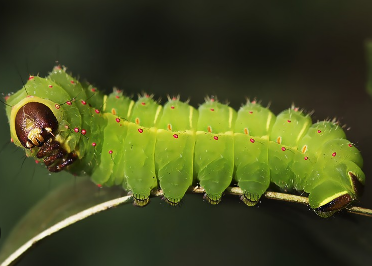
The caterpillar of the Honey Locust Moth is relatively large and striking in appearance. It typically measures around 2-3 inches in length. Its body is greenish-yellow and marked with longitudinal stripes or lines that are often pink or reddish in color.
As the name suggests, the Honey Locust Moth Caterpillar feeds on the leaves of honey locust trees (Gleditsia species). They are known to consume the foliage of these trees, which are found in various parts of North America.
Like many caterpillars, the Honey Locust Moth Caterpillar goes through several molts as it grows, shedding its old skin to reveal a new, larger one underneath. During these growth stages, its appearance may change slightly.
Eumorpha Sphinx Caterpillar (Eumorpha fasciatus)

The Eumorpha sphinx caterpillar is a species of caterpillar found in North and South America. It is a member of the Sphingidae family, which includes various species of moths commonly known as sphinx or hawk moths. The species was first described by Johann Heinrich Sulzer in 1776.
They are typically bright green with several diagonal white or yellowish stripes running along their body. These stripes can give the appearance of bands or loops. They can grow to a length of approximately 3 to 4 inches (7.5 to 10 centimeters).
When threatened, they often display a behavior known as “startle response.” This involves inflating their anterior segments to make themselves look larger, which can startle potential predators.
Eumorpha fasciatus caterpillars can be found in various habitats, including gardens, fields, and forests. They are known to feed on the leaves of various plants, including members of the nightshade family (Solanaceae), such as tomatoes and tobacco.
The adult Eumorpha fasciatus moth is a robust and attractive insect with a wingspan of approximately 2 to 3 inches (5 to 7.5 centimeters). It has a brownish-gray coloration with distinctive patterns on its wings, including a “V” shape.
Eumorpha fasciatus is found in various parts of North and South America, including the southern United States, Mexico, Central America, and parts of South America.
Tobacco Hornworm Caterpillar (Manduca sexta)

The Tobacco Hornworm caterpillar is a large, chubby green larva marked by diagonal white stripes adorned with black dots. Along its sides, it sports a series of black and yellow dots and a protruding horn at its rear, which can exhibit green, orange, or brown hues. While this caterpillar poses no threat to humans, it can inflict damage on crops such as tomato plants and other members of the nightshade family.
Distinguishing between tobacco hornworms and tomato hornworm caterpillars can be a challenge due to their similar appearances. Nevertheless, the plump tobacco hornworm is marginally smaller, measuring up to 2.7 inches (7 cm) in length.
To differentiate between the two hornworm varieties, examine their markings. For instance, tobacco hornworms display seven white diagonal lines with a black border, whereas tomato hornworms feature eight V-shaped markings devoid of borders and a black horn.
Common Pine Sawfly (Diprion pini)
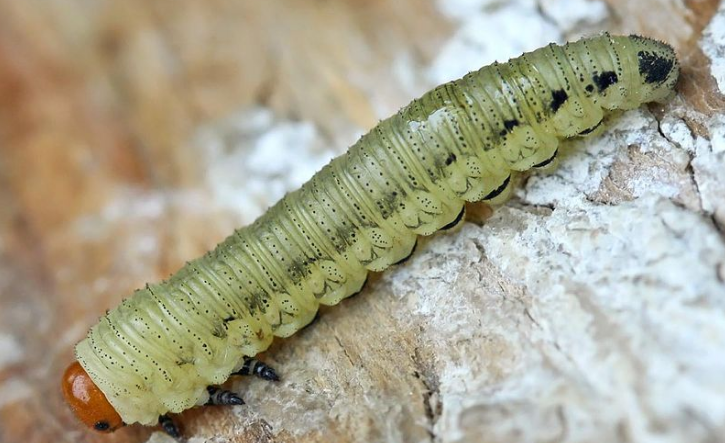
Diprion pini, the common pine sawfly, is a sawfly species in the family Diprionidae. Sawflies are insects belonging to the suborder Symphyta, which is closely related to ants, bees, and wasps. This species primarily feeds on pine trees. It is a serious pest of economic forestry, capable of defoliating large areas of pine forest. It occurs throughout Europe and Russia.
The Common Pine Sawfly larvae (caterpillar-like stage) have a distinctive appearance. They are generally greenish with black spots along their body and a pale yellow or white stripe on each side. They have several pairs of prolegs (fleshy leg-like structures) along their abdomen, which distinguishes them from true caterpillars.
While Common Pine Sawflies are generally not considered significant pests of pine forests, they can cause damage to individual trees when their populations become large. The feeding damage by the larvae can weaken pine trees and make them more susceptible to other stressors, such as drought or disease.
Polyphemus Moth Caterpillar (Antheraea polyphemus)
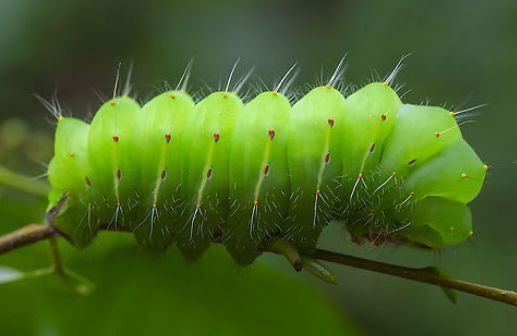
The caterpillar of the polyphemus moth displays a lime-green hue and features distinct bands of vibrant red dots running along its body. These neon-red dots are accompanied by long setae, which impart a slightly hairy appearance to the green caterpillar. The robust caterpillars typically measure between 3 to 4 inches (7.5 to 10 cm) in length.
As the polyphemus moth caterpillar progresses through its various developmental stages, its appearance undergoes changes. In its early stages, the caterpillar sports black and white stripes around its abdomen and is adorned with orange tubercles from which short black hairs protrude. During the pupation phase, it transforms into a large, dark green larva, occasionally featuring yellowish lines on its sides.
The species is widespread in continental North America, with local populations found throughout subarctic Canada and the United States. The caterpillar can eat 86,000 times its weight at emergence in a little less than two months.
Forester Moth Caterpillar (Zygaenidae)

The Zygaenidae moths are a family of Lepidoptera. The majority of zygaenids are tropical, but they are nevertheless quite well represented in temperate regions. Some of the 1000 or so species are commonly known as burnet or forester moths, often qualified by the number of spots, although other families also have ‘foresters’. They are also sometimes called smoky moths.
The caterpillars of Forester Moths are typically brightly colored and may have contrasting patterns. It is identified by two rows of black spots running along its back and spiky tufts. The plump, stout caterpillar has a segmented body and measures around 4.7” (12.5 cm) before it pupates. Its bright chartreuse color helps to ward off predators.
Forester moth caterpillars feed on herbaceous plants in the warm subtropical regions in the southern United States. The brightly-colored caterpillar turns into a spectacular black and white moth after pupation and is sometimes called a smoky moth.
Cross-Striped Cabbage Worm (Evergestis rimosalis)

The Cross-Striped Cabbage worm is a vibrant caterpillar with green stripes, a yellow band, and dark green spots. It displays zebra-like patterns, fine hairs, and a circular brown head. This caterpillar is among the most colorful of all green caterpillars. As it progresses in its development, the green coloration transitions to a deep blue or black shade.
Despite being referred to as a worm, the Cross-Striped Cabbage worm is, in fact, a caterpillar belonging to the Lepidoptera insect order. These striking, plump green caterpillars eventually transform into moths with a tan hue.
The size of Cross-Striped Cabbage worms typically ranges from 0.4 to 0.6 inches (1 to 1.5 cm) in length.
Long-Tailed Skipper Caterpillar (Urbanus proteus)
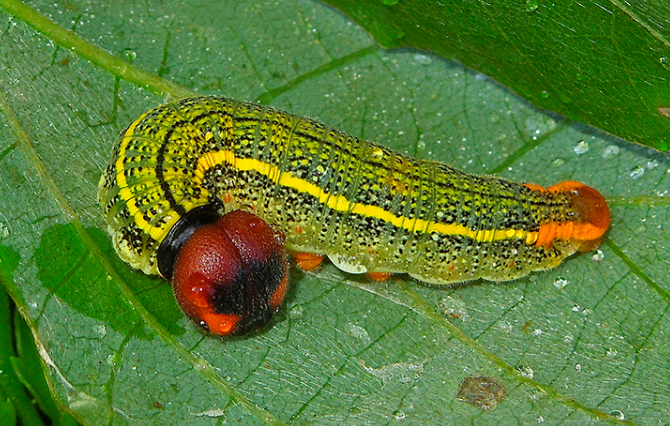
Long-Tailed Skipper Caterpillars have a unique appearance that distinguishes them from many other caterpillar species. They are typically green with a prominent, elongated tail-like extension (hence the name “long-tailed”). The tail may be adorned with a contrasting color, such as white or orange. These caterpillars can reach a length of about 1.5 inches (3.8 cm).
Long-Tailed Skipper Caterpillars are known for their solitary behavior. They feed on the leaves of various host plants, and their diet can include leguminous plants like beans, peas, and other members of the Fabaceae family. They use silk threads to create shelters by folding and attaching leaves together, providing protection while they feed.
This species is found throughout a broad range in the Americas, from the southern United States (including Florida and Texas) down through Central America and into parts of South America.
The adult Long-Tailed Skipper butterfly is striking with its blue-green coloration and long, narrow wings. They have a rapid, darting flight pattern and are often seen visiting flowers to feed on nectar. Their feeding behavior makes them important pollinators in their ecosystems.
Rough Prominent Moth (Nadata gibbosa)
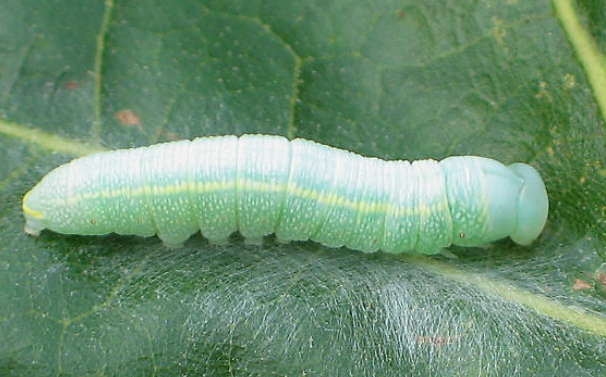
The Rough Prominent moth caterpillar is a pale green to turquoise, plump caterpillar with a large, rounded head and small black, eye-like markings. They have a slender, elongated body with a series of raised, tubercle-like structures along their back. These tubercles resemble small branches or twigs, helping the caterpillar blend in seamlessly with its surroundings.
The caterpillars of the Rough Prominent Moth can vary in size, but they are typically around 5 to 7 centimeters (2 to 2.8 inches) in length when fully grown. The caterpillar’s twig-like appearance provides it with excellent camouflage and protection against potential predators. When resting on a branch or among leaves, it can be very difficult for predators to spot due to its uncanny resemblance to a twig.
Like many caterpillar species, Rough Prominent Moth caterpillars are herbivorous and feed on the leaves of various deciduous trees and shrubs. They use their camouflage to hide from predators during their feeding and resting periods. The caterpillars feed on a variety of host plants, including oak (Quercus spp.), cherry (Prunus spp.), poplar (Populus spp.), and other deciduous trees and shrubs.
Cloudless Sulphur Butterfly (Phoebis sennae)

The caterpillar is green with yellow lateral lines, blue patches and small blue dots. Photo by Mary Keim.
The caterpillar of the Cloudless Sulphur Butterfly undergoes several instars or growth stages during its development. Initially, it hatches from an egg as a tiny, cylindrical larva with a greenish-yellow body and a black head. As it grows, it becomes more elongated and slender, with various color patterns. In later instars, it often exhibits a green or yellow-green coloration with longitudinal stripes or lines running along its body. These stripes may be white or yellow.
Cloudless Sulphur Butterfly caterpillars feed voraciously on the leaves of host plants in the Senna genus (such as Sicklepod and Coffee Senna). They are herbivores and use their chewing mouthparts to consume plant material. They may also exhibit a degree of camouflage to blend in with the foliage, helping to avoid predators.
The the caterpillars of Cloudless Sulphur Butterfly (Phoebis sennae) have a wide range across the Americas. Its distribution extends from the southern United States down through Central America and into South America.
Crowned Slug caterpillar (Isa textula)

The Crowned Slug caterpillar stands out as one of the most distinctive pale-green caterpillars. It can be readily distinguished by its flattened oval shape, adorned with stinging hairs protruding from its sides. Additionally, its distinguishing features include two lines running along its back, along with horns and two spiked tails.
Resembling a spherical leaf covered in fuzz, this slug caterpillar may appear flat, but it possesses a ridged back marked with two pale yellow lines. At one end, it sports a pair of horns, while the other end features clusters of stinging green spines. These stinging green, yellow, or red spiky projections encircling its body serve as prominent identifying characteristics.
The crowned slug caterpillar typically reaches a length of up to 0.6 inches (1.5 cm). Despite its captivating appearance, it should be handled with caution, as it has the potential to deliver a painful sting upon contact.
Oak Slug caterpillar (Euclea delphinii)

The oak slug caterpillar is an oval-shaped green caterpillar characterized by clusters of stinging spines, orange stripes, and circular black and white markings. Identifying this slug caterpillar is straightforward due to the presence of fuzzy orange or yellow spikes protruding from its back, extremities, and sides.
Its lime-green body, shaped like an oval, is segmented into three lateral sections by two rows of orange spines. These circular patterns featuring black and white rings are distinctive features found on its green dorsal surface.
The vibrant colors exhibited by the oak slug caterpillar serve as warning signals to deter potential predators. These caterpillars are commonly encountered in deciduous woodlands and forests. Following the pupal stage, this spiky caterpillar undergoes metamorphosis to emerge as a small, brown, and hairy moth.
The spiny oak slug caterpillar attains a maximum length of 0.8 inches (2 cm).
The Fall Webworm (Hyphantria cunea)
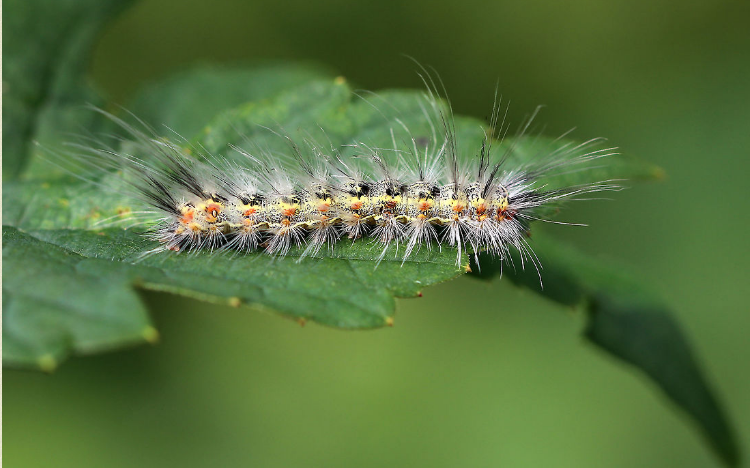
The Fall Webworm (Hyphantria cunea) is a common caterpillar species found in North America, particularly in the United States and Canada. It is also known as the Eastern Tent Caterpillar or the American Tent Caterpillar, although it is not to be confused with the Eastern Tent Caterpillar (Malacosoma americanum), which is a different species.
Fall Webworm caterpillars vary in color from pale yellow to greenish-yellow with rows of black dots along their body. They have long hairs or setae covering their body. Fall Webworm caterpillars are known for their distinctive web-like nests. They create silk tents or webs in the branches of trees, enclosing the leaves they feed on within these structures. These nests become larger as the caterpillars grow and feed.
Despite their name, Fall Webworm caterpillars are active during the late summer and early fall months. They create their nests in trees during this period, which is when they are most noticeable.
Spicebush Swallowtail Caterpillar (Papilio Troilus)
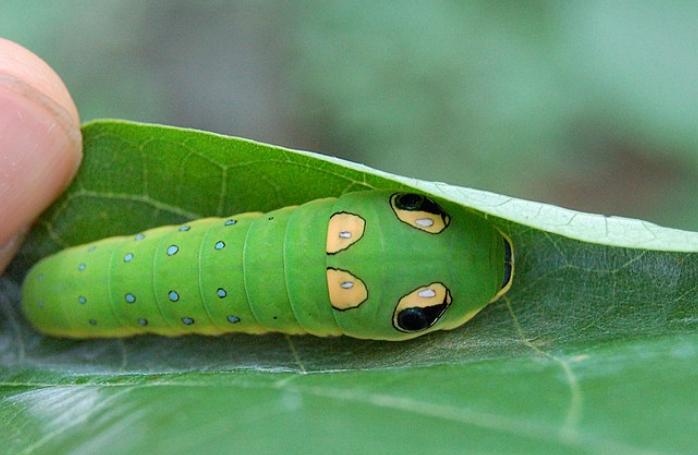
The Spicebush Swallowtail is a fat green to yellow caterpillar with bands of bluish-green dots around its segments. Its head has eye-like black and white markings, giving the spicebush swallowtail caterpillar the appearance of a comical snake.
Green spicebush swallowtail caterpillars grow between 2.5” and 3.8” (6 – 9.5 cm) long. They have a relatively plump body. During the early stages of growth, the caterpillars are brown with white markings that look like bird droppings. As they mature, they become pale green and develop burgundy or brown undersides.
One of the fascinating characteristics of the spicebush swallowtail is the false eyespots on its head that offer protection from predators. These have a black pupil on a yellowish oval circle and a white “reflection” spot.
If the spicebush swallowtail caterpillar feels threatened, it will rear up and emit a foul-smelling odor to ward off birds and other insects. It may be difficult to spot this caterpillar as it usually feeds at night and hides during the day.
Rosy Maple caterpillar (Dryocampa rubicunda)
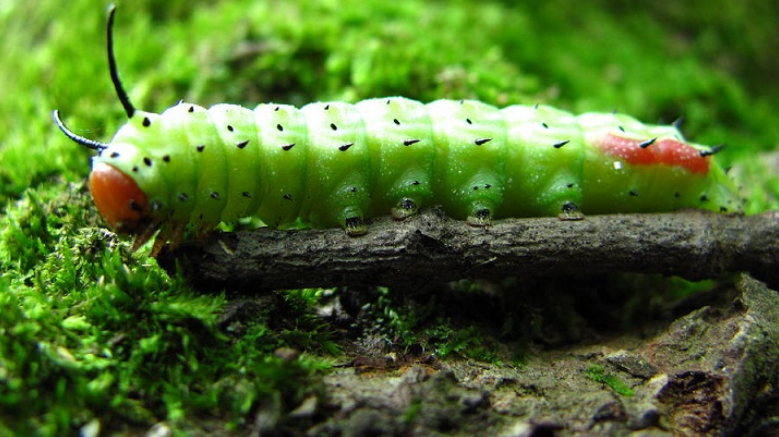
The Rosy Maple caterpillar is a vibrant green caterpillar marked with brown head, bands of black dots, and a set of black antennae. As this chubby green caterpillar matures, its appearance undergoes transformations. The rosy maple caterpillar acquires black spines, its bulbous brown head darkens, and white, green, or black stripes develop along its body.
When fully grown, Rosy maple caterpillars can reach up to 2 inches (5 cm) in length and sport a plump, striped green body. They are also known by the name “green-striped mapleworm.”
After completing the pupal stage, the formerly bright green caterpillar emerges from its cocoon as one of the most colorful furry moths. The rosy maple moth boasts vibrant pink and white fuzzy wings, a yellow head, and pink antennae.
Dragon-Headed Caterpillar (Polyura athamas)
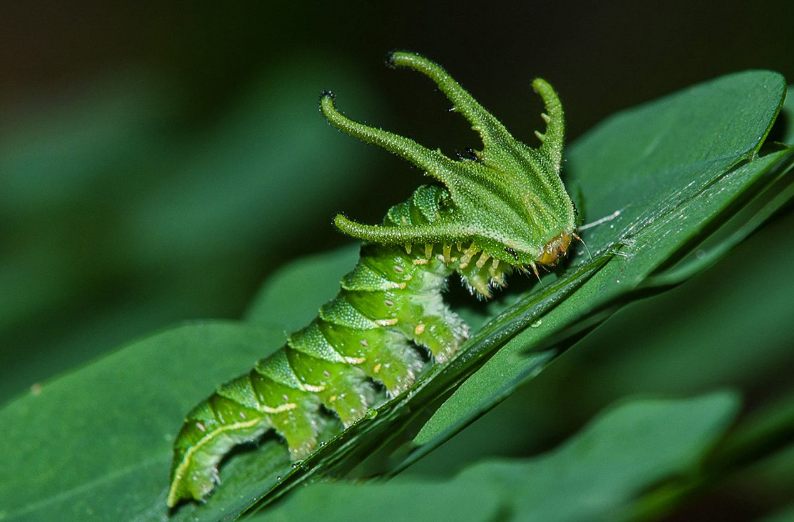
The Dragon-Headed caterpillar is a lengthy, dark-green caterpillar that resembles a slug, featuring a sizable head, four intimidating-looking horns, whitish-yellow stripes running along its sides, and small white dots. Despite its fearsome appearance, this caterpillar is harmless. It typically feeds on leguminous plants in tropical regions.
When observing images of the green dragon-headed caterpillar, it becomes evident why it bears the name Polyura athamas. The caterpillar’s green head resembles a mythical dragon, complete with two elongated central spiky “horns” and two shorter peripheral stubby horns protruding from its flat head.
Additionally, you’ll observe that the dragon-headed caterpillar possesses four sets of prolegs, each adorned with a white marking. Furthermore, there is a line of white markings running along the base of each segment. When viewed from above, these markings form a V shape.
Further References
- Caterpillars, Comparative Study: https://www.researchgate.net/publication/238029535_Caterpillars_as_Social_Insects
- Green Caterpillars: https://owlcation.com/stem/Green-Caterpillar-Identification
- Caterpillars Pest of Trees: http://extension.msstate.edu/content/caterpillar-pests-trees
- Caterpillars on Ornamental plants: https://extension.umn.edu/yard-and-garden-insects/caterpillars-ornamental-plants
- Puss Caterpillar Stings: https://www.uofmhealth.org/health-library/tm6502
- Caterpillars in Your Yard and Garden: https://extension.missouri.edu/ipm1019?p=50